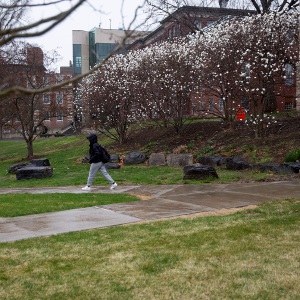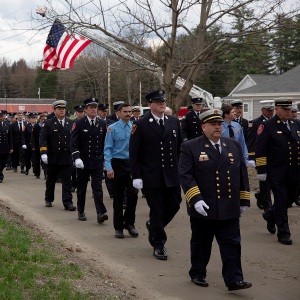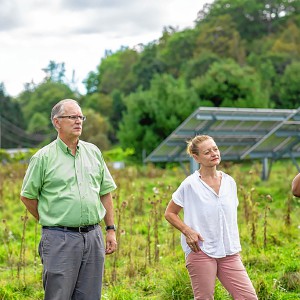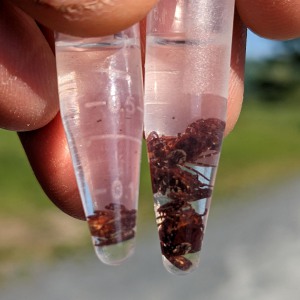Abandoned Springfield, Vt., factory the focus of event hailing state brownfields cleanup money
| Published: 09-16-2021 9:20 PM |
SPRINGFIELD, Vt. — An abandoned and sprawling machine tool factory at the gateway to downtown, long a ghostly reminder of the region’s economic decline, will finally be demolished and the site remediated thanks to a new funding program from the state to clean up some of Vermont’s worst contaminated sites.
The 270,000-square-foot former Jones & Lamson Machine Co. building on Clinton Street, aka Route 11, once employed 1,500 factory workers and was the crown of Springfield’s manufacturing hub. It will be receiving an estimated $3.7 million administered through Vermont’s Brownfield Economic Revitalization Alliance program, said Bob Flint, executive director of the Springfield Regional Development Corp., which owns the 14-acre property.
“It’s an understatement to say this is just another brownfield site. This beats them all,” Flint said Thursday in front of the entrance of the Jones & Lamson factory, now overgrown with ivy, during an event to trumpet the state setting aside money from a $210 million budget surplus for brownfield cleanup. In attendance were Gov. Phil Scott and other state, federal and town officials.
Flint, who has led the effort to redevelop the site for more than 15 years but could make only limited headway because of the costs involved in remediation, called the money from the state “a game-changer” in getting the project done.
“Probably every consultant in the state has touched this one time or another,” he said.
The state has allocated $25 million of the surplus for brownfields cleanup, and $14 million worth in recipients were announced on Thursday. Brownfields cleanup money historically originates from Environmental Protection Agency funds, or in limited cases from municipal budgets, but this brownfields funding is the first time the state has ever used its own money, officials said Thursday.
“This presents a once-in-a-lifetime opportunity to address longtime challenges and finally make good on the promise to increase economic equity from region to region and bring growth to all areas of the state, not just Chittenden County,” Scott said in announcing the recipients, which also include two sites in Burlington and a site in St. Albans.
SRDC acquired the abandoned Jones-Lamson property out of bankruptcy for $165,000.
Article continues after...
Yesterday's Most Read Articles
 Zantop daughter: ‘I wish James' family the best and hope that they are able to heal’
Zantop daughter: ‘I wish James' family the best and hope that they are able to heal’
 Crowd turns out to honor late Ascutney Fire Chief Darrin Spaulding
Crowd turns out to honor late Ascutney Fire Chief Darrin Spaulding
 A Life: For Kevin Jones ‘everything was geared toward helping other people succeed’
A Life: For Kevin Jones ‘everything was geared toward helping other people succeed’
 Pick a sport and Pete DePalo’s has probably officiated it over the past 40-plus years
Pick a sport and Pete DePalo’s has probably officiated it over the past 40-plus years
 Out & About: Vermont Center for Ecostudies continues Backyard Tick Project
Out & About: Vermont Center for Ecostudies continues Backyard Tick Project
The factory, the oldest section of which dated to 1907, was “the mother of the big three” machine tool companies in Springfield, along with Fellows Gear Shaper Co. and Bryant Grinder. It closed in 1986.
Over the years nearly $2.5 million, including $1.2 million from the EPA, has already been spent on assessments and preliminary cleaning of the site, which is contaminated with a host of toxic industrial chemicals, including polychlorinated biphenyls (PCBs); trichloroethylene (TCE); and light, non-aqueous phase liquid.
The $3.7 million in state funding will go to the Mount Ascutney Regional Commission, which is contracting with Costello Dismantling of West Wareham, Mass., to demolish and clean up the site. Flint said he expects work to begin in a few weeks and last at least through the early fall.
Although the building has been an unoccupied husk for 35 years — the roof has collapsed in places and it is considered highly dangerous to enter — SRDC has still been spending about $10,000 annually in maintenance costs and paying $5,000 to $6,000 per year in property taxes to the town.
Flint said two portions of the building will remain: about 10,000 square feet facing Bridge Street that had been the factory’s front office, and the backside end that houses LBL Fabrications and was the last section of the massive factory to be built.
As to what kind of business might someday occupy the redeveloped site, Flint declined to specify, but he did describe plans to return the site to its commercial roots.
“It won’t be residential, and the use will be something that is job-producing and will have a positive economic impact,” he said. “It won’t be a warehouse with two people working there or minimum-wage jobs.”
But Flint argues the site, next to the Black River and less than 3 miles from Interstate 91, should attract interested parties because it is “located near the highway exit with a four-lane access road, full water and sewer, one of the fastest internet systems in the country and it’s on flat land, which is hard to come by around here.”
Contact John Lippman at jlippman@vnews.com.

 Former principal of South Royalton School released from prison
Former principal of South Royalton School released from prison Upper Valley residents among advocates for NH aid-in-dying bill
Upper Valley residents among advocates for NH aid-in-dying bill 
